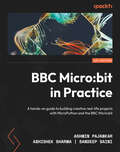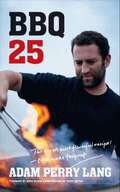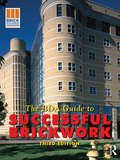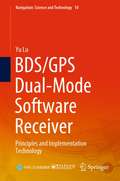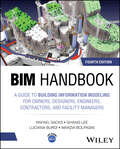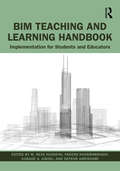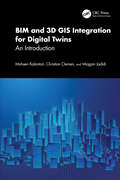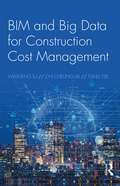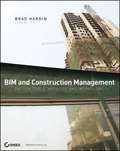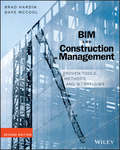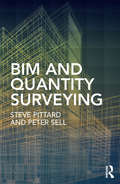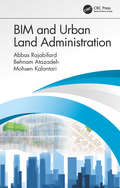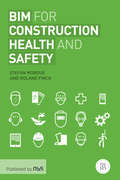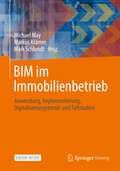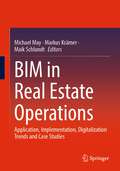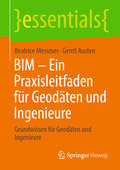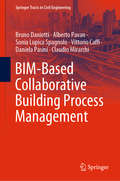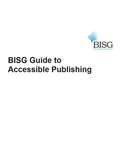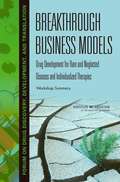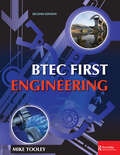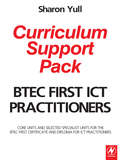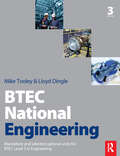- Table View
- List View
BBC Micro: A hands-on guide to building creative real-life projects with MicroPython and the BBC Micro:bit
by Ashwin Pajankar Sandeep Saini Abhishek SharmaDevelop real-world interactive physical computing applications using the Micro:bit with more than 100 MicroPython examples with circuit diagramsKey FeaturesExplore hardware programming and leverage the power of the BBC Micro:bit and MicroPythonBuild real-life creative projects step by step with each chapter increasing in complexity and interactivityLearn the features of the Micro:bit and how to interface it with electronic components through circuits and code examplesBook DescriptionThis book is a one-stop guide for learning BBC Micro:bit with MicroPython, exploring many hardware components and programming techniques to provide detailed insights into developing practical applications with the Micro:bit. It will also show you how hardware components can be manipulated using a combination of Micro:bit and MicroPython for developing practical projects. BBC Micro:bit in Practice will help you gain a holistic understanding of the BBC Micro:bit platform and MicroPython programming, guiding you through mini projects aimed at developing practical knowledge of circuit design and writing programs. You'll learn how to write programs for working with built-in LEDs and buttons, interfacing external LEDs, buttons, motors, buzzers, and much more. You'll also work with built-in radio, speakers, accelerometer, and a compass. You'll dive into concepts related to the Micro:bit filesystem, interfacing external displays, and working with libraries in detail before exploring sewable circuits and wearable technology.After reading this Micro:bit book, you'll understand how to apply principles in electronics and MicroPython to create interesting real-life projects from scratch.What you will learnExplore the essentials of the BBC Micro:bit, its hardware specifications, and versionsProgram built-in and external LEDs and buttonsProgram external LED-based displays, buzzers, and stepper motorsUse analog input and pulse width modulation to drive a servo motorDetect gestures with internal sensors such as accelerometer, compass, and magnetometerWork on projects with built-in features such as music, speech, radio, and filesystemExplore the advanced features of the Micro:bitWho this book is forThis book is for anyone who wants to use the combination of MicroPython and the BBC Micro:bit for building exciting real-life projects. Engineers, researchers, hobbyists, and technology instructors working in areas such as embedded systems, electronics, software development, IoT, robotics, teaching, and training will find this book useful for building projects. Prior experience with building basic electronic circuits and any programming language, not necessarily MicroPython, will be helpful.
BBQ 25: The World's Most Flavorful Recipes—Now Made Foolproof
by Adam Perry LangNew York Times Bestelling author and BBQ maestro Adam Perry Lang is back! Serious Barbecue meets A Man, A Can, A Plan in BBQ 25: an ultra-foolproof guide to the 25 most popular barbecue dishes, in a format anyone can follow with guaranteed success.
BDA Guide to Successful Brickwork
by The Brick Development AssociationThe BDA Guide to Successful Brickwork is the definitive practical guide to obtaining successful results in brickwork construction. Written by a team of experts from the Brick Development Association, the representative group in industry for brickwork construction, this best-selling text has now been brought fully in line with the latest British and European Standards, including the requirements of the new European Standard for Bricks EN771-1, to ensure readers are receiving the most up-to-date and accurate information available in the field.Based on actual teaching practice, the book is highly illustrated throughout to increase accessibility of the text for the reader in its exploration of the practical aspects of brickwork. It also includes an extensive glossary of brickwork terms for ease of reference. The third edition contains new material detailing recent innovations in brickwork, in the areas of components, systems and techniques, which includes the development of thin-joint techniques for both brickwork and blockwork.Students following NVQs and Construction Awards in Trowel Occupations (bricklaying route, at Foundation, Intermediate and Advanced level) from CITB, will find this book to be an invaluable source of information which will accompany them throughout their studies. The text has additional relevance to BTEC National and Higher Nationals in Construction, as well as GNVQ Intermediate and AVCE Construction and Built Environment courses. Building professionals concerned with the design, detailing and specification of brickwork will also find The BDA Guide to be an essential reference.
BDS/GPS Dual-Mode Software Receiver: Principles and Implementation Technology (Navigation: Science and Technology #10)
by Yu LuThis book introduces readers to the algorithm of Compass & GPS dual-system software receivers, and to the software implementation. It provides detailed descriptions of key theories in the fields of signal processing, communication, control, and signal estimation. The book is based on the author’s extensive experience in GNSS receiver design. The MATLAB script developed for this book demonstrates most of the key theories and equips the reader with excellent tools for practicing them.
BIM Handbook: A Guide to Building Information Modeling for Owners, Designers, Engineers, Contractors, and Facility Managers
by Rafael Sacks Ghang Lee Marzia Bolpagni Luciana BurdiUnderstand the latest advances in BIM with this fully updated guide Building Information Modeling (BIM) has become an increasingly central component of architecture and the building trades. Modern BIM software has moved beyond the simple 2D and 3D modeling tools of the past to incorporate simulation, analysis, project management, and more. BIM Handbook: A Guide to Building Information Modeling for Owners, Designers, Engineers, Contractors, and Facility Managers has long served as the essential introduction to this subject and its ever-expanding applications. Now fully updated to reflect the increasing standardization of BIM practices and its cutting-edge industry frameworks, the latest edition of this key text remains the fundamental tool for understanding the backbone of innovation in construction technology. Readers of the fourth edition of BIM Handbook will also find: Expanded treatment of the owner’s perspective in BIM and BIM integration Detailed discussion of new industry-specific frameworks such as ISO 19650 Exploration of the relationship between BIM and digital twins for construction, operations, and maintenance BIM Handbook is ideal for any professionals in the building trades, including owners and operators of buildings, architects, engineers, contractors, fabricators, developers of BIM software, and more.
BIM Teaching and Learning Handbook: Implementation for Students and Educators
by M. Reza Hosseini Farzad Khosrowshahi Ajibade Aibinu Sepehr AbrishamiThis book is the essential guide to the pedagogical and industry-inspired considerations that must shape how BIM is taught and learned. It will help academics and professional educators to develop programmes that meet the competences required by professional bodies and prepare both graduates and existing practitioners to advance the industry towards higher efficiency and quality. To date, systematic efforts to integrate pedagogical considerations into the way BIM is learned and taught remain non-existent. This book lays the foundation for forming a benchmark around which such an effort is made. It offers principles, best practices, and expected outcomes necessary to BIM curriculum and teaching development for construction-related programs across universities and professional training programmes. The aim of the book is to: Highlight BIM skill requirements, threshold concepts, and dimensions for practice; Showcase and introduce tried-and-tested practices and lessons learned in developing BIM-related curricula from leading educators; Recognise and introduce the baseline requirements for BIM education from a pedagogical perspective; Explore the challenges, as well as remedial solutions, pertaining to BIM education at tertiary education; Form a comprehensive point of reference, covering the essential concepts of BIM, for students; Promote and integrate pedagogical consideration into BIM education. This book is essential reading for anyone involved in BIM education, digital construction, architecture, and engineering, and for professionals looking for guidance on what the industry expects when it comes to BIM competency.
BIM and 3D GIS Integration for Digital Twins: An Introduction
by Mohsen Kalantari Christian Clemen Mojgan JadidiBuilding information modelling (BIM) uses a combination of technologies and resources to capture, manage, analyse, and display a digital representation of the physical and functional characteristics of a facility. A Geographic Information System (GIS) offers tools for visualising and analysing built and natural environments and their impacts on infrastructure systems, such as land use, transportation, etc. This book offers a framework for how the geospatial and surveying industry can create and integrate BIM with GIS. Through practical implementation methods, readers will learn to merge GIS data with design and BIM data to enable digital twins.This book presents the following features: Integrates BIM and GIS from a geospatial and surveying point of view for the first time; Addresses the creation of BIM from existing constructed buildings instead of typical pre-construction scenarios; Explains how to deliver BIM-suitable surveys to surveyors and geospatial practitioners; Provides surveying and geospatial industry expertise in the collecting, locating, managing, and communicating of BIM; Introduces new knowledge on the validation and integration of BIM and GIS within the spatial industry. This is an excellent book for professionals working with 3D data for built-environment digital twins, such as city planners, land surveyors, and geospatial practitioners. It is also an insightful resource for those working and studying in the fields of GIS, surveying, and geospatial engineering, providing the most current tools and resources for dealing with BIM.
BIM and Big Data for Construction Cost Management
by Weisheng Lu Chi Cheung Lai Tung TseThis book is designed to help practitioners and students in a wide range of construction project management professions to understand what building information modelling (BIM) and big data could mean for them and how they should prepare to work successfully on BIM-compliant projects and maintain their competencies in this essential and expanding area. In this book, the state-of-the-art information technologies that support high-profile BIM implementation are introduced, and case studies show how BIM has integrated core quantity surveying and cost management responsibilities and how big data can enable informed decision-making for cost control and cost planning. The authors' combined professional and academic experience demonstrates, with practical examples, the importance of using BIM and particularly the fusion of BIM and big data, to sharpen competitiveness in global and domestic markets. This book is a highly valuable guide for people in a wide range of construction project management and quantity surveying roles. In addition, implications for project management, facilities management, contract administration, and dispute resolution are also explored through the case studies, making this book essential reading for built environment and engineering professionals.
BIM and Construction Health and Safety: Uncovering, Adoption and Implementation (Spon Research)
by Robin Drogemuller Saeed Banihashemi Hamed Golzad Carol HonThis book aims to conceptualise the implementation of building information modelling (BIM) in the workplace health and safety (WHS) management of construction projects to reduce occupational accidents. The safety performance of the construction industry has always been a concern across the globe, and this devastating reputation has drawn the concern of many nations. The potential functions of BIM can drastically alter the WHS practices of the construction industry. BIM facilitates WHS information exchange and management and supports better collaboration and project planning through virtual visualisation of the construction WHS management process. Despite an increasing interest in BIM, a successful mechanism for employing BIM in construction WHS management is absent. Therefore, this book aims to fill this dearth by presenting a model for the integration of such innovative interventions with the current industry practices in a practical manner through the proper identification of effective areas and evaluation of their impacts on the key criteria of construction projects and organisations. This approach will foster the implementation of BIM in the current state of WHS management in the industry and can potentially reduce occupational accidents on construction sites. This book is essential reading for researchers and professionals interested in how BIM technology can improve health and safety on construction projects. It is intended for engineers, project managers, construction managers, safety officers and safety managers.
BIM and Construction Management
by Brad HardinOffering practical advice and tested techniques, this book serves as the first and only building information modeling (BIM) integration guide for the construction industry. You'll explore crucial construction tasks such as estimating, staging, sustainability testing, multiple model trade coordination, and digital detail resolution. In addition, the book also looks at facility management models and offers a clear picture of how the featured tools, techniques, and workflows can benefit each discipline.
BIM and Construction Management
by Brad Hardin Dave MccoolA sleeker, more comprehensive approach to construction projects BIM and Construction Management, Second Edition is a complete integration guide, featuring practical advice, project tested methods and workflows, and tutorials for implementing Building Information Modeling and technology in construction. Updated to align with the latest software editions from Autodesk, Trimble and Bentley, this book provides a common sense approach to leveraging BIM to provide significant value throughout a project's life cycle. This book outlines a results-focused approach which shows you how to incorporate BIM and other technologies into all phases of construction management, such as: Project planning: Set up the BIM project to succeed right from the start by using the right contracts, the right processes and the right technology Marketing: How to exceed customer expectations and market your brand of BIM to win. Pre-construction: Take a practical approach to engineer out risks in your project by using the model early to virtually build and analyze your project, prior to physical construction. Construction: Leverage the model throughout construction to build safer and with better quality. Field work: Learn how mobile technologies have disrupted the way we work in the field to optimize efficiencies and access information faster. Closeout: Deliver a better product to your customer that goes beyond the physical structure and better prepares them for future operations. Additionally, the book provides a look at technology trends in construction and a thoughtful perspective into potential use cases going forward. BIM and Construction Management, Second Edition builds on what has changed in the construction landscape and highlights a new way of delivering BIM-enabled projects. Aligning to industry trends such as Lean, integrated delivery methods, mobile platforms and cloud-based collaboration this book illustrates how using BIM and technology efficiently can create value.
BIM and Quantity Surveying
by Peter Sell Steve PittardThe sudden arrival of Building Information Modelling (BIM) as a key part of the building industry is redefining the roles and working practices of its stakeholders. Many clients, designers, contractors, quantity surveyors, and building managers are still finding their feet in an industry where BIM compliance can bring great rewards. This guide is designed to help quantity surveying practitioners and students understand what BIM means for them, and how they should prepare to work successfully on BIM compliant projects. The case studies show how firms at the forefront of this technology have integrated core quantity surveying responsibilities like cost estimating, tendering, and development appraisal into high profile BIM projects. In addition to this, the implications for project management, facilities management, contract administration and dispute resolution are also explored through case studies, making this a highly valuable guide for those in a range of construction project management roles. Featuring a chapter describing how the role of the quantity surveyor is likely to permanently shift as a result of this development, as well as descriptions of tools used, this covers both the organisational and practical aspects of a crucial topic.
BIM and Urban Land Administration
by Abbas Rajabifard Behnam Atazadeh Mohsen KalantariRapid urbanization has created an unprecedented pressure on the use of land in cities around the world, resulting in physical and legal complexities. This book explains the theoretical basis and practicality of connecting urban land administration practices with the 3D digital data environment of Building Information Modelling (BIM). The main focus is to adopt a BIM-based paradigm for enhancing communication and management of complex ownership rights in multi-story buildings, which are prevalent in urban built environments. This book first elaborates on a range of data elements required for managing legal information in current land administration practices pertaining to subdivision of legal interests within multi-story building developments. It then explains how an open data model in the BIM domain – Industry Foundation Classes (IFC) – can be extended with legal data elements to lay the foundation for adopting BIM in urban land administration. The book also highlights benefits and barriers of implementing BIM-enabled urban land administration. Features Explains the theoretical basis and practicality of connecting urban land administration practices with the 3D digital data environment of BIM. Highlights the existing challenges associated with current practice of urban land administration for multi-story buildings. Introduces the potential of 3D digital environment of BIM for the purpose of mapping and registering legal interests. Describes how BIM-based data models can be extended for recording, managing, and representing legal ownership of properties over a building's lifecycle. Includes models of multi-story buildings as case studies to demonstrate the feasibility of extended BIM-based data models.
BIM for Construction Health and Safety
by Stefan Mordue Roland FinchWhat is BIM and how does it affect the health and safety professional? How are BIM technologies used on a practical level? What opportunities are there for the use of BIM in the health and safety arena? This concise and practical guide aims to answer all these questions and more. The health and safety role is evolving towards collaboration, structured data and sharing of information as BIM – the incarnation of these sensibilities - increasingly underpins construction practice. As the industry begins to see how these two topics can and should intersect this guide provides context and practical advice by explaining the basic principles of BIM, how it will shape the health and safety professional’s role and what tools and processes will need to be embedded in the future. It also highlights the wealth of opportunities that BIM provides to improve health and safety standards and effective coordination – the means to exploit the potential of BIM.
BIM im Immobilienbetrieb: Anwendung, Implementierung, Digitalisierungstrends und Fallstudien
by Michael May Markus Krämer Maik SchlundtDieses Fachbuch – nicht nur für Praktiker – beschäftigt sich mit allen Facetten und Fragestellungen der Anwendung von Building Information Modeling (BIM) im Immobilienbetrieb und Facility Management (FM).Ausgehend von den Grundlagen und Vorzügen von BIM sowie dessen Entwicklung, werden alle Bereiche im Immobilienbetrieb beleuchtet, bei denen BIM sinnvoll eingesetzt werden kann. Dabei werden BIM- und CAFM-Grundlagen, moderne Digitalisierungstechniken, Datenstandards und Datenaustausch sowie Interoperabilität und Aspekte der Wirtschaftlichkeit von BIM-Projekten ausführlich erläutert. Das Vorgehen bei der BIM-Einführung, Anwendungsszenarien und konkrete Praxisbeispiele runden das Werk ebenso ab wie ein Blick in aktuelle Forschungsthemen und künftige Entwicklungen.
BIM in Real Estate Operations: Application, Implementation, Digitalization Trends and Case Studies
by Michael May Markus Krämer Maik SchlundtThis reference book - not only for practitioners - deals with all facets and issues of the application of Building Information Modeling (BIM) in real estate operations and Facility Management (FM).Starting from the basics and advantages of BIM as well as its development, all areas in real estate operations are illuminated where BIM can be usefully applied. BIM and CAFM basics, modern digitization techniques, data standards and data exchange, as well as interoperability and aspects of the economic viability of BIM projects are explained in detail. The procedure for introducing BIM, application scenarios and concrete practical examples round off the work, as does a look at current research topics and future developments.
BIM – Ein Praxisleitfaden für Geodäten und Ingenieure: Grundwissen für Geodäten und Ingenieure (essentials)
by Beatrice Messmer Gerrit AustenZiel dieses Essentials ist es, Basiswissen zu Building Information Modeling (BIM) für den Fachbereich der Geodäsie und deren Nachbardisziplinen aus nationaler sowie internationaler Literatur zusammenzufassen und praktische Empfehlungen daraus abzuleiten. Der zunehmende Digitalisierungsgrad bei Bauvorhaben durch die Anwendung von BIM und das steigende Automatisierungspotential klassischer geodätischer Tätigkeiten begründen die Notwendigkeit, betroffene Aufgaben- und Tätigkeitsfelder in der Vermessung weiter zu entwickeln.
BIM-Based Collaborative Building Process Management (Springer Tracts in Civil Engineering)
by Bruno Daniotti Alberto Pavan Sonia Lupica Spagnolo Vittorio Caffi Daniela Pasini Claudio MirarchiThe book reports on the great improvements in the information and knowledge management due to the digitalization of the building sector. By summarizing several research projects addressing the implementation of BIM in different stages of the building process, and the definition of standards at Italian, European and international levels for managing information relying on the implementation of BIM-based processes, it showcases the efforts, especially within the Italian building sector, to build a standardized structure of information and develop tools for collecting, sharing and exchanging information between stakeholders involved in different stages of the building process, so as to enhance the storage, traceability, usability and re-usability of information management. Further, it presents an enhanced use of information that relies on the adoption of the standardized structure of information, and proposes dedicated applications for automating the process of information fruition. Lastly, it features a digital platform for different stakeholders in the building sector, such as manufacturers, producers and construction companies.
BISG Guide to Accessible Publishing: 2019 Edition
by Bill Kasdorf Elaine Ober Robin SeamanThe BISG Quick Start Guide to Accessible Publishing offers both a succinct introduction to the basics of accessibility and the market advantages to publishers for adopting best practices in creating accessible digital content. It is available in the EPUB 3 format and serves as a model of a properly accessible publication. <P><P>The guide addresses why and how to create, distribute, and display accessible digital content and provides an overview of these topics: <br>The critical importance of accessibility <br>The business case for making content accessible <br>Practical advice on how best to make content accessible <br>Legal requirements for accessible content <P><P>The BISG Quick Start Guide to Accessible Publishing can help companies: <br>Make content more discoverable <br>Reach an untapped market <br>Streamline production workflow <br>Save money by creating "born accessible" educational materials <P><P>This is a critical and hopeful time, when technology and massive industry shifts are mitigating the constant catch-up effort that currently limits access and requires so much extra work to create accessible content. With the BISG Quick Start Guide to Accessible Publishing, publishers will discover an invaluable resource. When all digital content is also “born accessible,” the dream of equal access to information for everyone will be a reality.
BREAKTHROUGH BUSINESS MODELS: Drug Development for Rare and Neglected Diseases and Individualized Therapies
by Institute of Medicine of the National AcademiesThe process for developing new drug and biologic products is extraordinarily expensive and time-consuming. Although large pharmaceutical companies may be able to afford the cost of development because they can expect a large return on investment, organizations developing drugs to treat rare and neglected diseases are unable to rely on such returns. On June 23, 2008, the Institute of Medicine's Forum on Drug Discovery, Development, and Translation held a public workshop, "Breakthrough Business Models: Drug Development for Rare and Neglected Diseases and Individualized Therapies," which sought to explore new and innovative strategies for developing drugs for rare and neglected diseases.
BRICS Countries: Challenges and Opportunities
by Faizal Bux Yiping Li Hirok Chaudhuri Otto Corrêa Rotunno Filho Natalia GusevaThis book provides a detailed study and assessment of water resources management andpollution control in different BRICS countries. The regions involved areBrazil, Russia, India, China and South Africa. This book gives importantinsight into how future sustainability depends on the development of effectivewater governance mechanisms at the level of countries. According to theregional characteristics from different aspects it cuts into the waterenvironment problems and studies in different ways, which is multifaceted andtargeted. Using case studies that include environmentally integrated basinexperiments (eibex) of Brazil, groundwater overflow zone of India, semi-aridriver basin of South Africa and so on, this volume provides criticalinformation for researchers and policymakers.
BROWNIAN RATCHETS: From Statistical Physics to Bio and Nano-motors
by David Cubero Ferruccio RenzoniIllustrating the development of Brownian ratchets, from their foundations, to their role in the description of life at the molecular scale and in the design of artificial nano-machinery, this text will appeal to both advanced graduates and researchers entering the field. Providing a self-contained introduction to Brownian ratchets, devices which rectify microscopic fluctuations, Part I avoids technicalities and sets out the broad range of physical systems where the concept of ratchets is relevant. Part II supplies a single source for a complete and modern theoretical analysis of ratchets in regimes such as classical vs quantum and stochastic vs deterministic, and in Part III readers are guided through experimental developments in different physical systems, each highlighting a specific unique feature of ratchets. The thorough and systematic approach to the topic ensures that this book provides a complete guide to Brownian ratchets for newcomers and established researchers in physics, biology and biochemistry.
BTEC First Engineering
by Mike TooleyA clearly written and easily accessible textbook that encourages independent study, covering all the core material required for the BTEC First Certificate and Diploma. Knowledge-check questions and activities are included throughout, along with review questions and worked mathematical examples, all of which relate to real-world engineering contexts.Students will gain a valuable insight into various areas of engineering technology and related industries, providing a potential springboard to further training, qualifications, or suitable employment. For those students wishing to progress to BTEC National, this textbook covers all the vital material required as a prerequisite to NVQ Level 3.New in this edition:• Updated in line with the 2010 changes to the BTEC First specifications• Includes detailed information on assessment, featuring example questions and answers• Layout and design changes provide extra clarity
BTEC First ICT Practitioners Curriculum Support Pack
by Sharon YullUsed alongside the students’ text, BTEC First in ICT for Practitioners, this pack offers an essential suite of photocopiable handouts with student activities and case studies for the compulsory core units and selected specialist units of the 2006 BTEC First in ICT for Practitioners schemes from Edexcel.Full coverage is given to the core units of the Certificate and Diploma (units 1 and 2) and to the selected specialist units covered in the textbook:* Using ICT to Present Information (Unit 1)* Introduction to Computer Systems (Unit 2)* Website Development (Unit 4)* Networking Essentials (Unit 6)* Database Software (Unit 9)* Spreadsheet Software (Unit 10)* ICT Graphics (Unit 18)In addition, the ICT Project (Unit 3) is supported with handouts with activities to guide students through project planning and problem solving techniques. Also available in electronic form on the CD-ROM, this pack will save teachers and course teams many hours work preparing handouts and assignments and is freely photocopiable within the purchasing institution. The CD-ROM also contains selected illustrations from the textbooks for lecturers to use in their own presentations and handouts.Sharon Yull is a Senior Lecturer at City College Norwich and a Senior Subject Examiner for Higher Nationals in Computing for Edexcel. Sharon also runs the Training and Education Company, an IT and education consultancy and has written books for other BTEC IT qualifications.
BTEC National Engineering
by Mike Tooley Lloyd DingleFirst Published in 2010. Routledge is an imprint of Taylor & Francis, an informa company.
